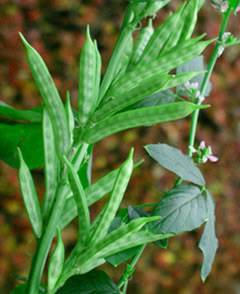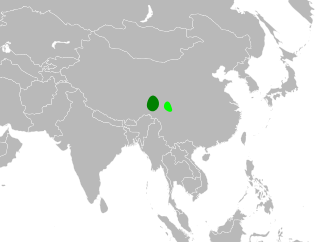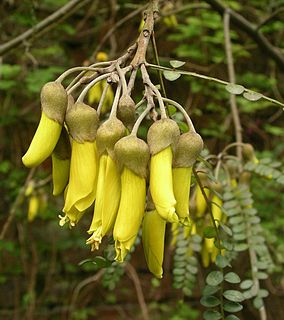Related Research Articles

Cyamopsis is a genus of the family Fabaceae. Its species are distributed across Africa, Asia and the Pacific.

Camoensia is a genus of 2 species of lianas in the family Fabaceae, subfamily Faboideae, native to the Gulf of Guinea, Africa. C. scandens is cultivated as an ornamental plant; it has one of the largest leguminous flowers, up to 20 cm across. The genus has classically been assigned to the tribe Sophoreae, but was recently assigned to its own monophyletic tribe, Camoensieae, on the basis of molecular phylogenetic evidence. Species of Camoensia are known to produce quinolizidine alkaloids, consistent with their placement in the genistoid clade.

Baphia is a small genus of legumes that bear simple leaves. Baphia is from the Greek word βάπτω, referring to a red dye that is extracted from the heartwood of tropical species. The genus is restricted to the African tropics. Baphia was traditionally assigned to the tribe Sophoreae; however, recent molecular phylogenetic analyses reassigned Baphia to the tribe Baphieae.
Phylloxylon is a genus of flowering plants in the Indigofereae tribe of the family Fabaceae. There are seven species, all endemic to Madagascar.

Crotalarieae is a tribe of flowering plants belonging to the bean family, Fabaceae. It includes rooibos (Aspalathus linearis), harvested for sale as a tisane.

Amphimas is a small genus of flowering plants in the legume family, Fabaceae. It belongs to the subfamily Faboideae. It is a west African tree used for medicine and for wood. Amphimas was traditionally assigned to the tribe Sophoreae; however, recent molecular phylogenetic analyses reassigned Amphimas into an unspecified position in the Meso-Papilionoideae.

Chaetocalyx is a genus of lianas in the legume family, Fabaceae. It belongs to the subfamily Faboideae, and was recently assigned to the informal monophyletic Adesmia clade of the Dalbergieae. Members of this genus are found in Central and South America. Chaetocalyx can be distinguished from most other legumes by its climbing habit, its imparipinnate leaves, and, in most species, by its elongate loments. It can be distinguished from Nissolia, which also has a climbing habit, by the articles of the loments, which are uniform in size in Chaetocalyx, rather than with a terminal, expanded, winglike article as in Nissolia. Unlike most papilionoid legumes, Chaetocalyx species do not form root nodules.

Cytisophyllum sessilifolium is a species of flowering plants in the legume family, Fabaceae. It belongs to the subfamily Faboideae. It is the only member of the genus Cytisophyllum.
Dalhousiea is a genus of flowering plants in the legume family, Fabaceae. It belongs to the subfamily Faboideae. It was named after Christian Ramsay, Countess of Dalhousie, by Robert Graham for her work in the classification of Indian botany. Dalhousiea was traditionally assigned to the tribe Sophoreae; however, recent molecular phylogenetic analyses reassigned Dalhousiea into the Baphieae tribe.

Euchresta is a genus of flowering plants in the legume family, Fabaceae. It belongs to the subfamily Faboideae and is the only genus in the tribe Euchresteae.
Leucomphalos is a genus of flowering plants in the legume family, found in west Africa. It belongs to the subfamily Faboideae. Leucomphalos was traditionally assigned to the tribe Sophoreae; however, recent molecular phylogenetic analyses reassigned Leucomphalos to the Baphieae tribe.

Platypodium is a genus of flowering plants in the legume family, Fabaceae. It belongs to the subfamily Faboideae, and was recently assigned to the informal monophyletic Pterocarpus clade within the Dalbergieae.
Rhynchotropis is a genus of flowering plants in the legume family, Fabaceae. It belongs to the tribe Indigofereae of the subfamily Faboideae.

Salweenia is a genus of flowering plants in the legume family, Fabaceae. It belongs to the subfamily Faboideae.

The tribe Indigofereae is a subdivision of the plant family Fabaceae. It is consistently recovered as a monophyletic clade in molecular phylogenies. The Indigofereae arose 30.0 ± 3.3 million years ago.

The tribe Sophoreae is one of the subdivisions of the plant family Fabaceae. Traditionally this tribe has been used as a wastebasket taxon to accommodate genera of Faboideae which exhibit actinomorphic, rather than zygomorphic floral symmetry and/or incompletely differentiated petals and free stamens. Various morphological and molecular analyses indicated that Sophoreae as traditionally circumscribed was polyphyletic. This led to a re-circumscription of Sophoreae, which resulted in the transfer of many genera to other tribes. This also necessitated the inclusion of two former tribes, Euchresteae and Thermopsideae, in the new definition of Sophoreae. Tribe Sophoreae, as currently circumscribed, consistently forms a monophyletic clade in molecular phylogenetic analyses. The Sophoreae arose 40.8 ± 2.4 million years ago.

The robinioids are one of the four major clades in subfamily Faboideae of the flowering plant family Fabaceae (Leguminosae). It is composed of the traditional tribes Loteae, Sesbanieae and Robinieae. It is a large and important clade that is distributed in mostly temperate areas. Species in this clade share a unique determinate root nodule structure. The clade is predicted to have diverged from the other legume lineages 48.3±1.0 million years ago.
Baphiastrum is a genus of flowering plants in the legume family, found in west Africa. It belongs to the subfamily Faboideae. Baphiastrum was traditionally assigned to the tribe Sophoreae; however, recent molecular phylogenetic analyses reassigned Baphiastrum to the Baphieae tribe.
Indigastrum is a genus in the tribe Indigofereae of the family Fabaceae.
Microcharis is a genus in the tribe Indigofereae of the family Fabaceae.
References
- ↑ Cardoso D, Pennington RT, de Queiroz LP, Boatwright JS, Van Wykd BE, Wojciechowskie MF, Lavin M (2013). "Reconstructing the deep-branching relationships of the papilionoid legumes" (PDF). S Afr J Bot . 89: 58–75. doi: 10.1016/j.sajb.2013.05.001 .
- 1 2 "The Plant List entry for Disynstemon". The Plant List . Royal Botanic Gardens, Kew and the Missouri Botanical Garden. 2013. Retrieved 1 February 2017.
- ↑ Du Puy DJ, Labat J-N, Rabevohitra R, Villiers J-F, Bosser J, Moat J (2002). The Leguminosae of Madagascar. Royal Botanic Gardens, Kew. p. 737. ISBN 978-1-900-34791-4.
- ↑ Schrire BD, Lavin M, Barker NP, Forest F (2009). "Phylogeny of the tribe Indigofereae (Leguminosae-Papilionoideae): Geographically structured more in succulent-rich and temperate settings than in grass-rich environments". Am J Bot . 96 (4): 816–52. doi:10.3732/ajb.0800185. PMID 21628237.
- ↑ Schrire BD (2013). "Kew entry for Disynstemon". www.kew.org. Royal Botanic Gardens, Kew, London, England. Archived from the original on 3 February 2017. Retrieved 1 February 2017.
- ↑ "ILDIS LegumeWeb entry for Disynstemon". International Legume Database & Information Service. Cardiff School of Computer Science & Informatics. Retrieved 1 February 2017.
- ↑ USDA; ARS; National Genetic Resources Program. "GRIN species records of Disynstemon". Germplasm Resources Information Network—(GRIN) [Online Database]. National Germplasm Resources Laboratory, Beltsville, Maryland. Retrieved 1 February 2017.